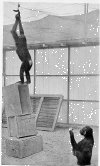This brief excerpt on Kohler's work is also from the book The Animal
Mind by J.L Gould & C. G. Gould
But there is more to the story. First, Kohler's films
are of chimpanzees that had repeatedly approached the problems in question; their
successes, such as they were, were achieved slowly. The crate stacking behavior, after
nearly three years of practice, remains laughably inept: the animals still try to balance
on a corner, or even position the crates so that the open end faces up, which makes it
difficult either to stack additional crates or find stable footing on the existing pile.
Later studies, notably Paul Schiller's attempt to reproduce Kohler's work in the late
1940s, demonstrated that experience  playing with the toys that later
become tools was essential to eventual success. He noted that if provided with sticks,
chimps poke and swing at almost anything ( and frequently at nothing at all), and try to
connect them into pairs with no reward in sight. Chimps love to climb on crates to provide
an elevated stage for swinging sticks, and to stack crates
for the apparent fun of it. Schiller reported that each tower-building chimp
"climbed on the tower jumping upward from the top repeatedly with arms lifted above
the head and stretched toward the ceiling. For the human observer it was hard to believe
that there was no food above them to be reached. Needless to say, none of these animals
had ever been tested in box-stacking problem situations."
playing with the toys that later
become tools was essential to eventual success. He noted that if provided with sticks,
chimps poke and swing at almost anything ( and frequently at nothing at all), and try to
connect them into pairs with no reward in sight. Chimps love to climb on crates to provide
an elevated stage for swinging sticks, and to stack crates
for the apparent fun of it. Schiller reported that each tower-building chimp
"climbed on the tower jumping upward from the top repeatedly with arms lifted above
the head and stretched toward the ceiling. For the human observer it was hard to believe
that there was no food above them to be reached. Needless to say, none of these animals
had ever been tested in box-stacking problem situations."
Beyond that by now familiar lesson that the cognitive underpinnings of a behavior often
seem to weaken as we learn more about the natural behavior of a species, there is the
further complication that the "operant" may actually be constructed of innate
motor programs linked together in just the UR-UR-UR-UR-UR sequence hypothesized by Watson.
The discovery that typical laboratory operants are actually either innate gestures or at
least innately constrained (as in the pecking styles of pigeons) should already have sown
the seeds of doubt. Chimpanzees may indeed have insight ( and we will look at
better-controlled experiments in later chapters); indeed, having the wit to realize that
something done in play-as one of many possible behavioral sequences, explored apparently
just for the fun of it-might solve a novel problem probably does qualify as
insight. Of course it represents a low-level, everyday sort of insight, and if we take a
hard line and require complete, from-the-ground-up novelty before conceding conscious
inspiration, then Kohler's pioneering work, though charming to read and watch, does not provide much unambiguous evidence one way or
the other. But by that standard few humans would get passing marks for cognitive prowess.
Back to Kohler